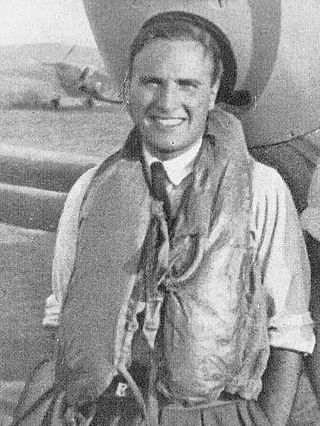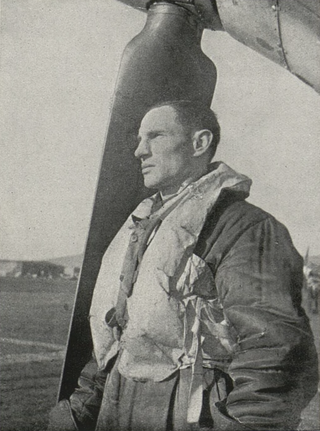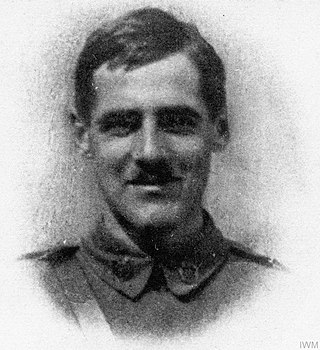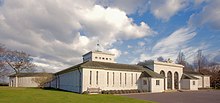
James Brindley Eric Nicolson, was a fighter pilot and wing commander in the Royal Air Force during the Second World War. He was a recipient of the Victoria Cross, the highest award for gallantry in the face of the enemy that can be awarded to British and Commonwealth forces, for his actions in August 1940 during the Battle of Britain.
James William Elias Davies, was an American combat fighter pilot who was the first American-born airman to die in combat in World War II. Davies was shot down and killed on 27 June 1940.

Wing Commander Lance Cleo "Wildcat" Wade DSO, DFC & Two Bars was an American pilot who joined the Royal Air Force (RAF) during the Second World War and became a flying ace. He remained with RAF until his death in a flying accident in 1944 in Italy. He was described as a "distinguished American fighter ace who epitomized perhaps more than any other American airman the wartime accords between Britain and the United States".

David Moore Crook, DFC was a British fighter pilot and flying ace of the Second World War.

Alois Vašátko DFC was a Czechoslovak artillery officer who became an air force pilot. In the Second World War he was a fighter ace, first in the French Air Force in the Battle of France and then in the Royal Air Force.

Wing Commander Howard Peter "Cowboy" Blatchford was a flying ace, who achieved the first Canadian victory in World War II.

Squadron Leader John Edwin Ashley "Willy" Williams was an Australian air ace during the Second World War. He served in the Middle East and North Africa with the Royal Air Force (RAF), and was among the Allied prisoners of war (POWs) murdered by the Gestapo following "The Great Escape" in 1944. He commanded No. 450 Squadron of the Royal Australian Air Force for three days, before he was captured in 1942.

Number 601 Squadron is a squadron of the RAF Reserves, based in London. The squadron took part in the Battle of Britain, during which the first Americans to fly in World War II were members of the squadron.
Joseph Cruess Callaghan, was an Irish flying ace of the First World War, credited with five aerial victories.
Squadron Leader David Mary Tidmarsh was an Irish-born flying ace of the Royal Flying Corps during the First World War, credited with seven aerial victories.
Captain Walter Alexander Tyrrell was a British First World War flying ace credited with seventeen aerial victories.

Captain Noel William Ward Webb was a British World War I flying ace credited with fourteen aerial victories. He also claimed the life of German ace Leutnant Otto Brauneck for his ninth victory.

The Arras Flying Services Memorial Commonwealth War Graves Commission war memorial in the Faubourg d'Amiens Cemetery, Arras, France. The memorial commemorates nearly 1,000 airmen from forces of the Commonwealth who were killed on the Western Front during World War I and who have no known grave. The memorial was designed by Edwin Lutyens, sculpted by William Reid Dick and unveiled by Hugh Trenchard, 1st Viscount Trenchard, Marshal of the Royal Air Force on 31 July 1932.
Ernest Melville Charles Guest was a Southern Rhodesian Royal Air Force pilot of the Second World War. He was awarded the Distinguished Flying Cross in 1942 having flown more than 1,000 operational hours. Posted to South Africa as a flight navigation instructor, he was unhappy and got himself transferred back to England on operational duties. He soon went missing in October 1943 after taking on six Ju 88s while on an anti-submarine sortie.

Flight Lieutenant Nicholas Gresham Cooke, DFC, nicknamed "Lanky", was a Royal Air Force pilot and Second World War flying ace most notable as an ace in a day. He was killed in action over the Dunkirk evacuation beaches.

Harold Leslie North, was a New Zealand flying ace of the Royal Air Force (RAF) during the Second World War. He was officially credited with the destruction of at least five German aircraft although postwar research indicates some uncertainty regarding his tally.
John Blandford Latta, was a Canadian-born officer who served in the Royal Air Force (RAF) during the Second World War. He was credited with at least seven aerial victories.

Joseph Émile Paul Larichelière was a Canadian officer who served in the Royal Air Force (RAF) during the Second World War. He is credited with six aerial victories.
Robert Wilkinson "Paddy" Turkington, was a Northern Irish Second World War Royal Air Force (RAF) fighter pilot and flying ace. He had 9 confirmed kills, 3 shared kills, 1 probable kill, and 4 damaged aircraft; some sources credit him with 11 kills.












